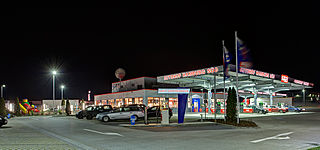
A rest area is a public facility located next to a large thoroughfare such as a motorway, expressway, or highway, at which drivers and passengers can rest, eat, or refuel without exiting onto secondary roads. Other names include motorway service area (UK), services (UK), travel plaza, rest stop, oasis (US), service area, rest and service area (RSA), resto, service plaza, lay-by, and service centre (Canada). Facilities may include park-like areas, fuel stations, public toilets, water fountains, restaurants, and dump and fill stations for caravans / motorhomes.
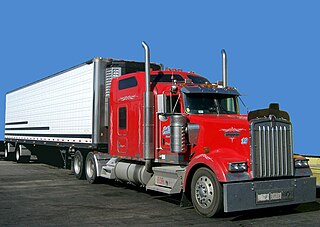
A commercial driver's license (CDL) is a driver's license required in the United States to operate large and heavy vehicles or a vehicle of any size that transports hazardous materials or more than 15 passengers.
Weigh-in-motion or weighing-in-motion (WIM) devices are designed to capture and record the axle weights and gross vehicle weights as vehicles drive over a measurement site. Unlike static scales, WIM systems are capable of measuring vehicles traveling at a reduced or normal traffic speed and do not require the vehicle to come to a stop. This makes the weighing process more efficient, and, in the case of commercial vehicles, allows for trucks under the weight limit to bypass static scales or inspection.

A truck driver is a person who earns a living as the driver of a truck, which is commonly defined as a large goods vehicle (LGV) or heavy goods vehicle (HGV).
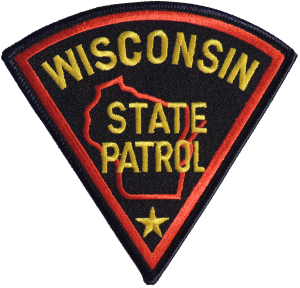
The Wisconsin State Patrol is the state patrol for the state of Wisconsin and is a division of the Wisconsin Department of Transportation. The Wisconsin State Patrol enforces traffic and criminal laws, oversees the motor carrier safety and weight facilities (SWEFs), inspects and regulates motor carriers, school buses and ambulances, and assists local law enforcement agencies with traffic safety, civil disturbances and disasters.

A weigh station is a checkpoint along a highway to inspect vehicular weights and safety compliance criteria. Usually, trucks and commercial vehicles are subject to the inspection.

A truck scale (US), weighbridge (non-US) or railroad scale is a large set of scales, usually mounted permanently on a concrete foundation, that is used to weigh entire rail or road vehicles and their contents. By weighing the vehicle both empty and when loaded, the load carried by the vehicle can be calculated.

The Oklahoma Department of Public Safety (ODPS) is a department of the government of Oklahoma. Under the supervision of the Oklahoma Secretary of Public Safety, DPS provides for the safety of Oklahomans and the administration of justice in the state. DPS is responsible for statewide law enforcement, vehicle regulation, homeland security and such other duties as the Governor of Oklahoma may proscribe.

The Tennessee Highway Patrol (THP) is the State Patrol organization for the U.S. state of Tennessee, responsible for enforcing all federal and state laws relating to traffic on the state's federal and state highways. The agency was created to protect the lives, property, and constitutional rights of people in Tennessee. The THP is a division of the Tennessee Department of Safety and Homeland Security.

The Louisiana Department of Transportation and Development (DOTD) is a state government organization in the United States, in charge of maintaining public transportation, roadways, bridges, canals, select levees, floodplain management, port facilities, commercial vehicles, and aviation which includes 69 airports, in the U.S. state of Louisiana. The agency has approximately five thousand personnel on staff and an operating budget of $2.3 billion. DOTD operations are run through nine district offices across the state.
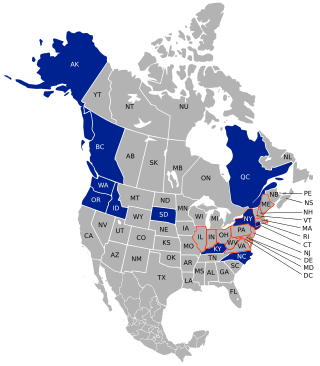
NORPASS is a not-for-profit organization formed from a partnership between state agencies and the North American trucking industry. The program issues electronic transponders and provides a weigh station bypassing service for truckers in Alaska, British Columbia, Connecticut, Idaho, Kentucky, North Carolina, New York, Oregon, Quebec, South Dakota, and Washington. Two service centres, operated by the Kentucky Transportation Center at the University of Kentucky and the Washington State Department of Transportation, coordinate efforts of NORPASS.
PrePass is an intelligent transportation system (ITS) that electronically verifies the safety, credentials, and weight of commercial vehicles as they approach participating state highway weigh stations. Because they comply electronically, commercial carriers enrolled in PrePass are authorized to bypass these facilities rather than pull in for manual inspection.

A Satellite Truck is a mobile communications satellite ground station mounted on a truck chassis as a platform. Employed in remote television broadcasts, satellite trucks transmit video signals back to studios or production facilities for editing and broadcasting. Satellite trucks usually travel with a production truck, which contains video cameras, sound equipment and a crew. A satellite truck has a large satellite dish antenna which is pointed at a communication satellite, which then relays the signal back down to the studio. Satellite communication allows transmission from any location that the production truck can reach, provided a line of sight to the desired satellite is available.

Hours of service (HOS) regulations are issued by the Federal Motor Carrier Safety Administration (FMCSA) and govern the working hours of anyone operating a commercial motor vehicle (CMV) in the United States. These regulations apply to truck drivers, commercial and intercity bus drivers, and school bus drivers who operate CMVs. These rules limit the number of daily and weekly hours spent driving and working, and regulate the minimum amount of time drivers must spend resting between driving shifts. For intrastate commerce, the respective state's regulations apply.
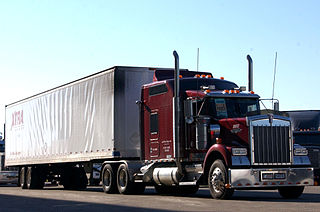
The trucking industry serves the American economy by transporting large quantities of raw materials, works in process, and finished goods over land—typically from manufacturing plants to retail distribution centers. Trucks are also used in the construction industry, two of which require dump trucks and portable concrete mixers to move the large amounts of rocks, dirt, concrete, and other building materials used in construction. Trucks in America are responsible for the majority of freight movement over land and are tools in the manufacturing, transportation, and warehousing industries.
The Highway Traffic Act is a statute in Ontario, Canada, which regulates the licensing of vehicles, classification of traffic offences, administration of loads, classification of vehicles and other transport-related issues. First introduced in 1923 to deal with increasing accidents during the early years of motoring in Ontario, and replacing earlier legislation such as the Highway Travel Act, there have been amendments due to changes to driving conditions and new transportation trends. For example, in 2009, the Act was revised to ban the use of cell phones while driving.

International Road Dynamics Inc. is a road traffic management system engineering company headquartered in Saskatoon, Saskatchewan, Canada. Its services include automated toll roads, commercial vehicle inspection systems, traffic data collection products, and traffic management software.

Arkansas Highway Police is a state police division of the Arkansas Department of Transportation. The Arkansas Highway Police is responsible for enforcing motor vehicle laws, traffic laws, and commercial vehicle enforcement. It is the second-largest state law enforcement agency in Arkansas after the Arkansas State Police. It was founded in 1929 and is the oldest law enforcement agency in Arkansas.
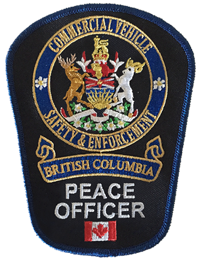
British Columbia Commercial Vehicle Safety & Enforcement is a provincial law enforcement agency that is responsible for the compliance and enforcement of the commercial transport sector, protection of the environment and transportation infrastructure of British Columbia, increasing road safety and protecting the motoring public.

The South Dakota Department of Public Safety (DPS) is a state agency in South Dakota, United States. DPS is an enforcement, licensing and services agency that develops and operates programs in the areas of law enforcement, traffic safety, fire safety, driver's licenses, emergency management, and public safety information. The Secretary of Public Safety is appointed by the Governor of South Dakota.
















